Strategic Management and Leadership Analysis for Woolworths Inc.
VerifiedAdded on 2021/06/17
|19
|5103
|29
Report
AI Summary
This report provides a detailed analysis of Woolworths' organizational strategy and leadership. It begins with an overview of the company, its history, and its position in the Australian retail market. The report then delves into the application of generic strategies, such as cost leadership and product differentiation, employed by Woolworths to gain a competitive advantage. Furthermore, it explores the relevance of human resource-based theory and game theory in the context of Woolworths' operations. A significant portion of the report is dedicated to the examination of organizational culture, including Harrison's and Handy's models, and how these models apply to Woolworths. Finally, the report discusses the formal organizational structure of Woolworths, providing a comprehensive understanding of the company's strategic management and leadership approaches.
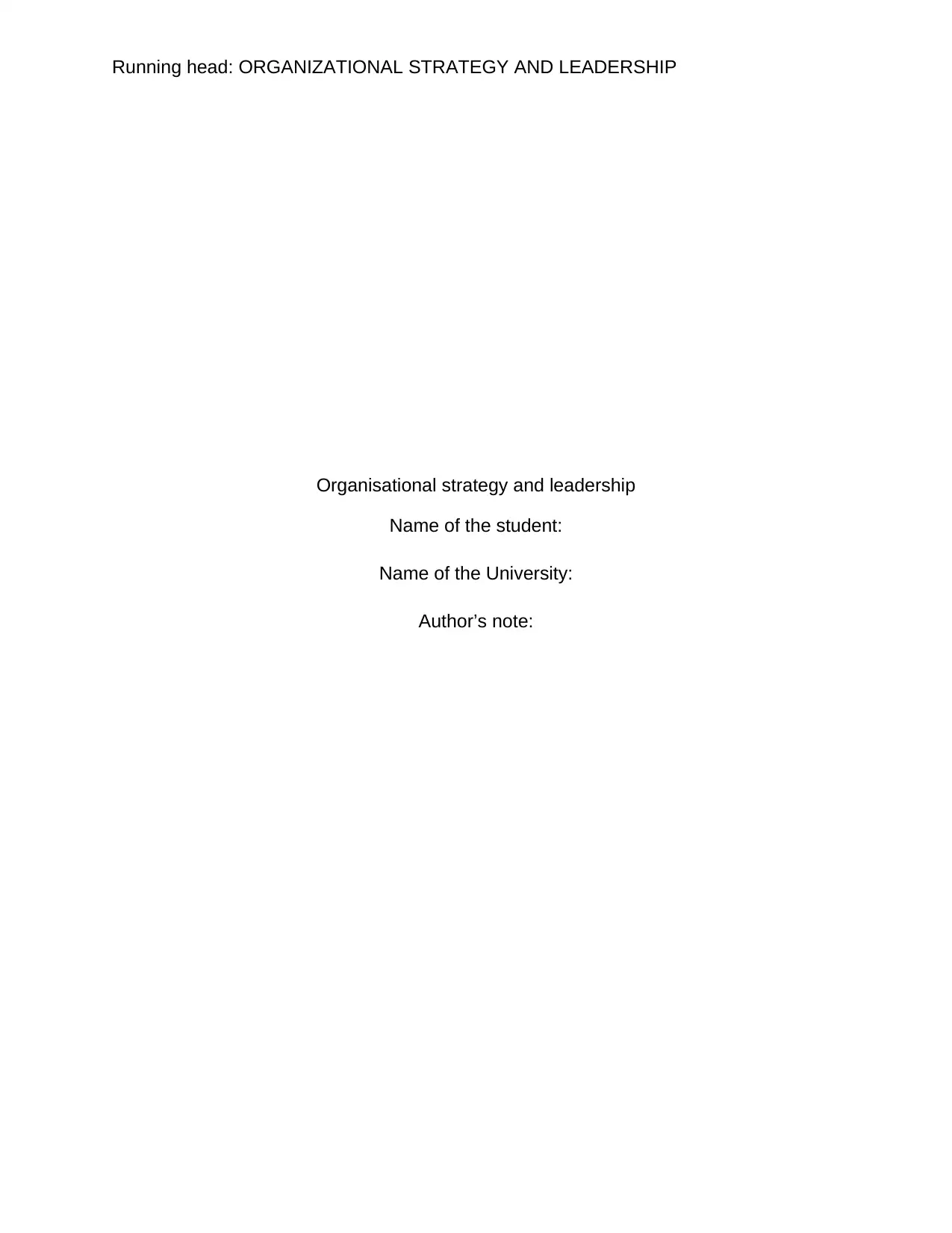
Running head: ORGANIZATIONAL STRATEGY AND LEADERSHIP
Organisational strategy and leadership
Name of the student:
Name of the University:
Author’s note:
Organisational strategy and leadership
Name of the student:
Name of the University:
Author’s note:
Paraphrase This Document
Need a fresh take? Get an instant paraphrase of this document with our AI Paraphraser
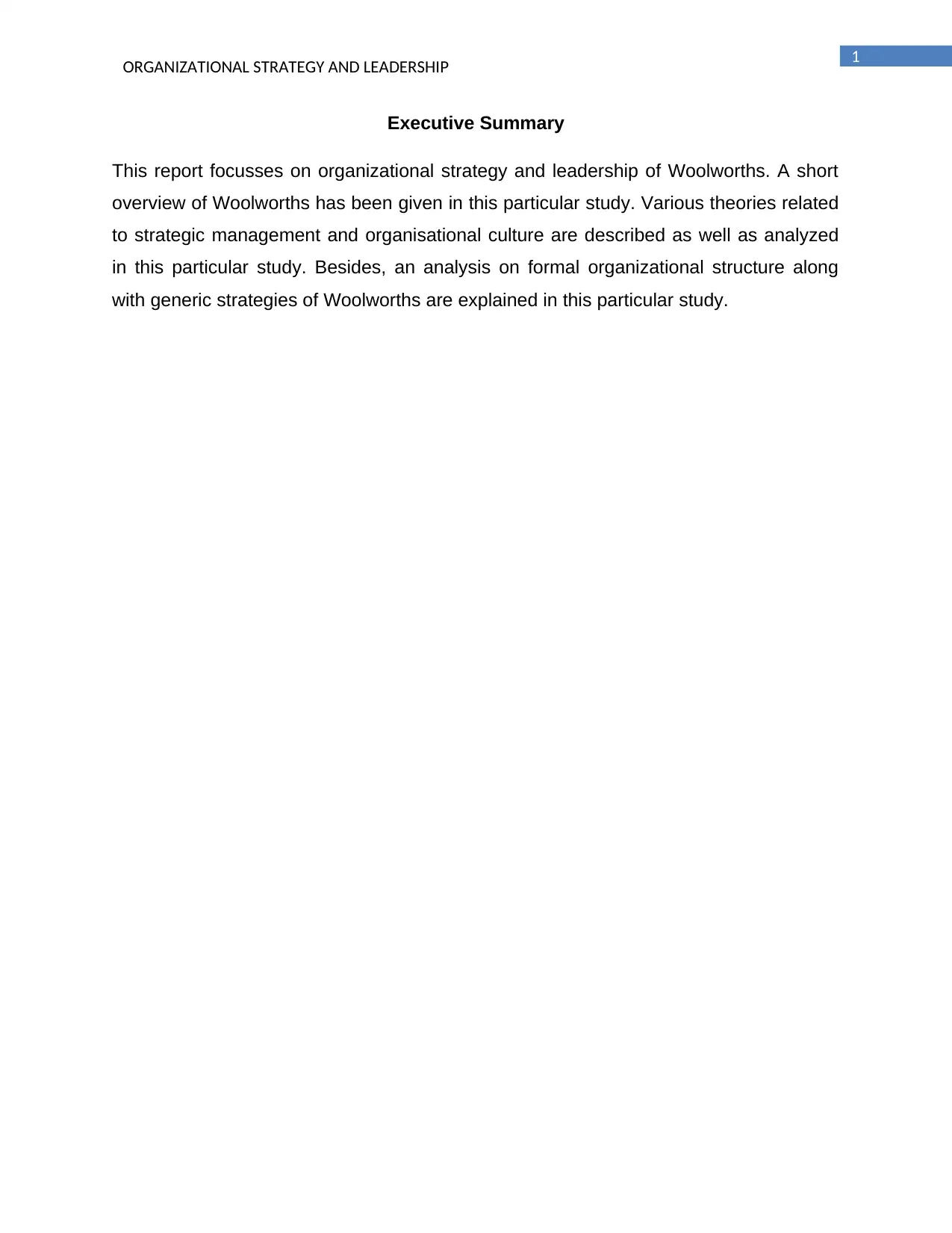
1
ORGANIZATIONAL STRATEGY AND LEADERSHIP
Executive Summary
This report focusses on organizational strategy and leadership of Woolworths. A short
overview of Woolworths has been given in this particular study. Various theories related
to strategic management and organisational culture are described as well as analyzed
in this particular study. Besides, an analysis on formal organizational structure along
with generic strategies of Woolworths are explained in this particular study.
ORGANIZATIONAL STRATEGY AND LEADERSHIP
Executive Summary
This report focusses on organizational strategy and leadership of Woolworths. A short
overview of Woolworths has been given in this particular study. Various theories related
to strategic management and organisational culture are described as well as analyzed
in this particular study. Besides, an analysis on formal organizational structure along
with generic strategies of Woolworths are explained in this particular study.
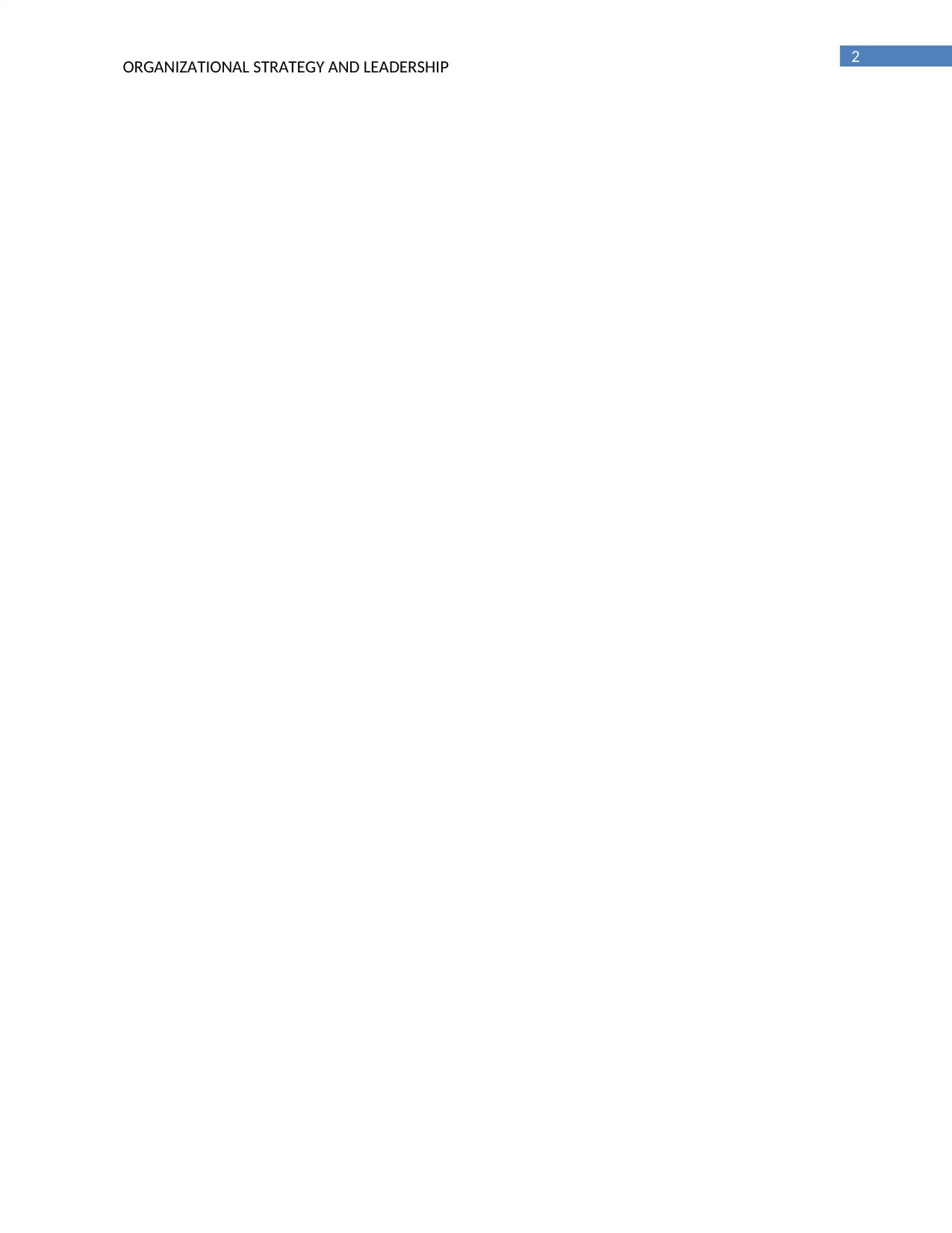
2
ORGANIZATIONAL STRATEGY AND LEADERSHIP
ORGANIZATIONAL STRATEGY AND LEADERSHIP
⊘ This is a preview!⊘
Do you want full access?
Subscribe today to unlock all pages.

Trusted by 1+ million students worldwide
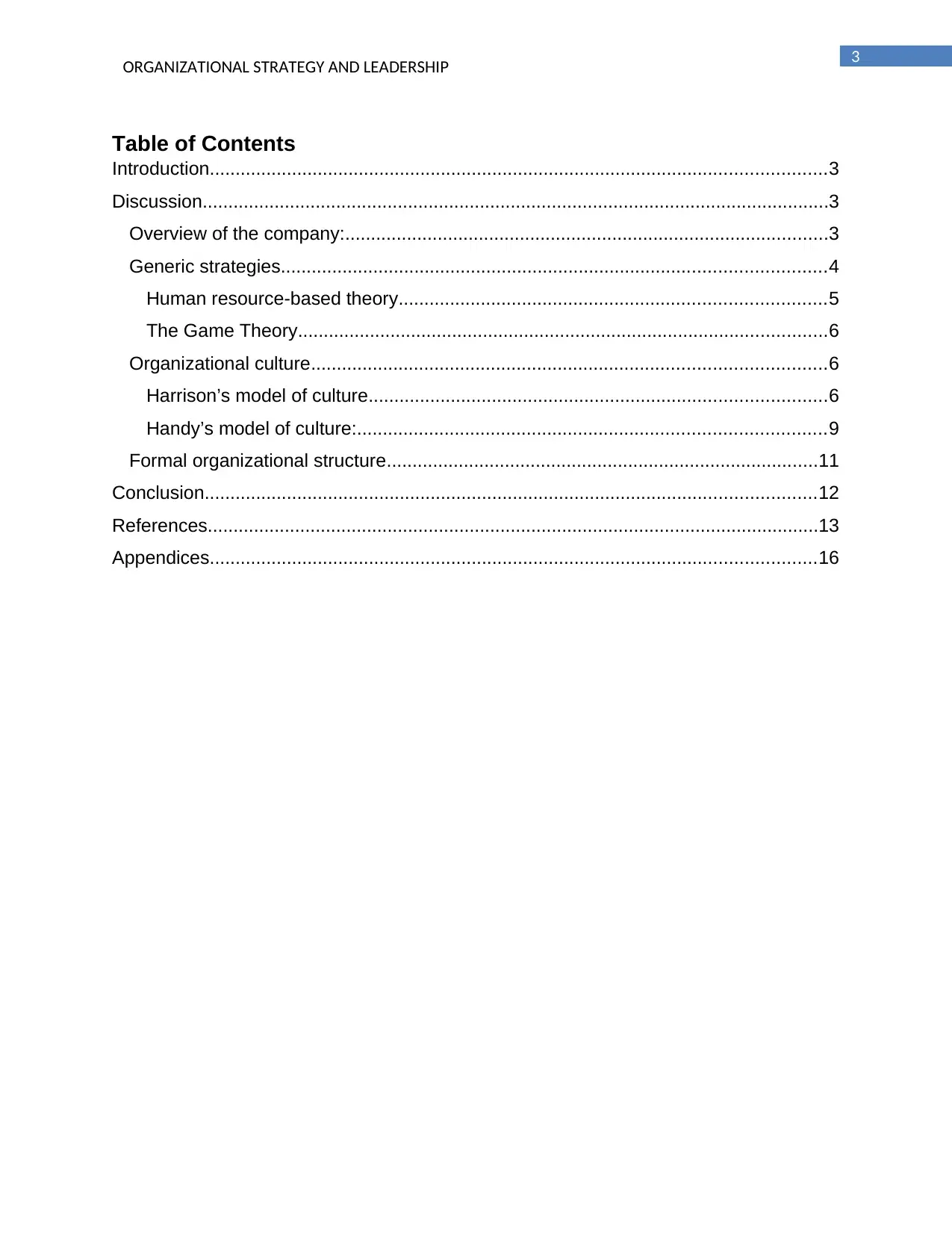
3
ORGANIZATIONAL STRATEGY AND LEADERSHIP
Table of Contents
Introduction........................................................................................................................3
Discussion..........................................................................................................................3
Overview of the company:..............................................................................................3
Generic strategies..........................................................................................................4
Human resource-based theory...................................................................................5
The Game Theory.......................................................................................................6
Organizational culture....................................................................................................6
Harrison’s model of culture.........................................................................................6
Handy’s model of culture:...........................................................................................9
Formal organizational structure....................................................................................11
Conclusion.......................................................................................................................12
References.......................................................................................................................13
Appendices......................................................................................................................16
ORGANIZATIONAL STRATEGY AND LEADERSHIP
Table of Contents
Introduction........................................................................................................................3
Discussion..........................................................................................................................3
Overview of the company:..............................................................................................3
Generic strategies..........................................................................................................4
Human resource-based theory...................................................................................5
The Game Theory.......................................................................................................6
Organizational culture....................................................................................................6
Harrison’s model of culture.........................................................................................6
Handy’s model of culture:...........................................................................................9
Formal organizational structure....................................................................................11
Conclusion.......................................................................................................................12
References.......................................................................................................................13
Appendices......................................................................................................................16
Paraphrase This Document
Need a fresh take? Get an instant paraphrase of this document with our AI Paraphraser
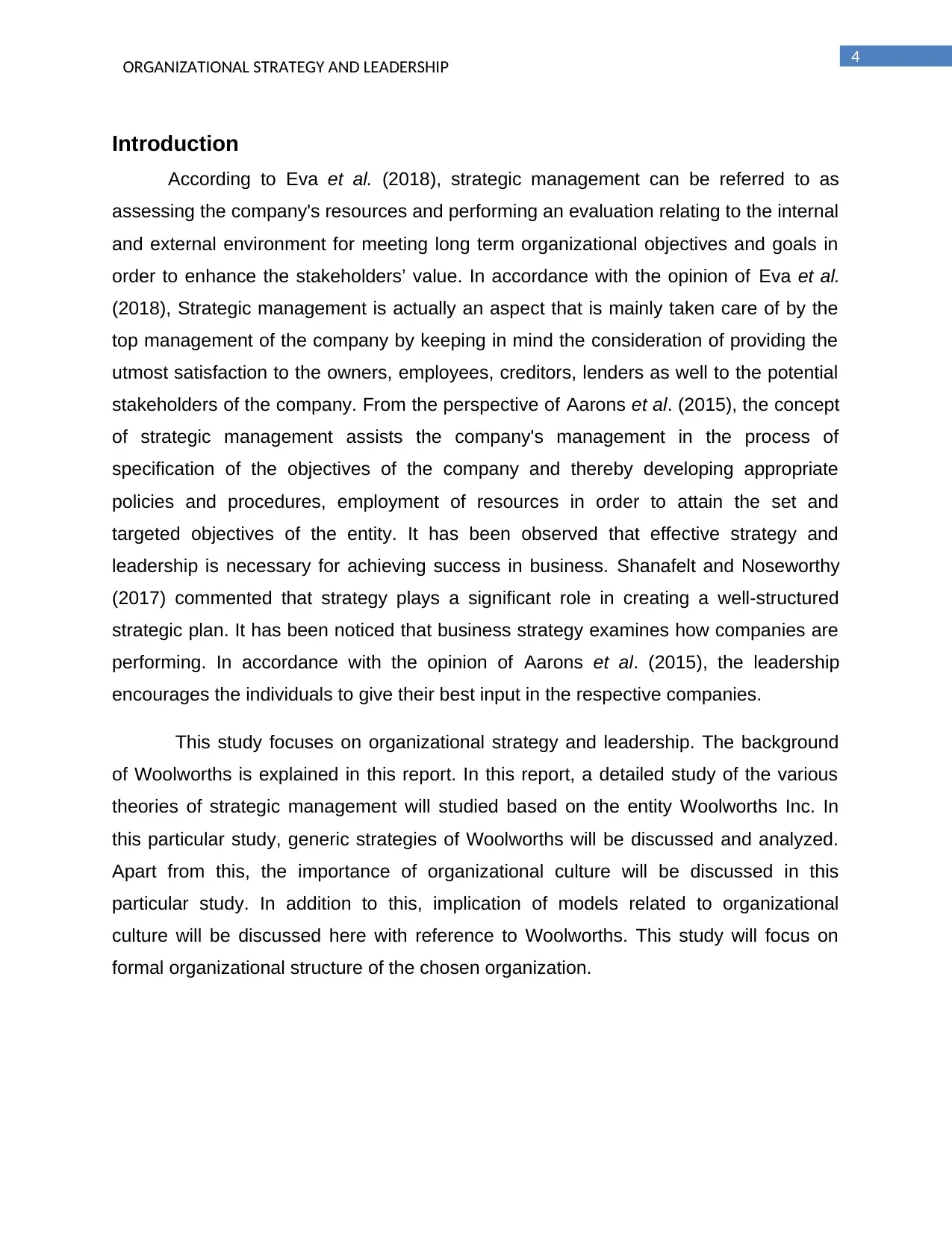
4
ORGANIZATIONAL STRATEGY AND LEADERSHIP
Introduction
According to Eva et al. (2018), strategic management can be referred to as
assessing the company's resources and performing an evaluation relating to the internal
and external environment for meeting long term organizational objectives and goals in
order to enhance the stakeholders’ value. In accordance with the opinion of Eva et al.
(2018), Strategic management is actually an aspect that is mainly taken care of by the
top management of the company by keeping in mind the consideration of providing the
utmost satisfaction to the owners, employees, creditors, lenders as well to the potential
stakeholders of the company. From the perspective of Aarons et al. (2015), the concept
of strategic management assists the company's management in the process of
specification of the objectives of the company and thereby developing appropriate
policies and procedures, employment of resources in order to attain the set and
targeted objectives of the entity. It has been observed that effective strategy and
leadership is necessary for achieving success in business. Shanafelt and Noseworthy
(2017) commented that strategy plays a significant role in creating a well-structured
strategic plan. It has been noticed that business strategy examines how companies are
performing. In accordance with the opinion of Aarons et al. (2015), the leadership
encourages the individuals to give their best input in the respective companies.
This study focuses on organizational strategy and leadership. The background
of Woolworths is explained in this report. In this report, a detailed study of the various
theories of strategic management will studied based on the entity Woolworths Inc. In
this particular study, generic strategies of Woolworths will be discussed and analyzed.
Apart from this, the importance of organizational culture will be discussed in this
particular study. In addition to this, implication of models related to organizational
culture will be discussed here with reference to Woolworths. This study will focus on
formal organizational structure of the chosen organization.
ORGANIZATIONAL STRATEGY AND LEADERSHIP
Introduction
According to Eva et al. (2018), strategic management can be referred to as
assessing the company's resources and performing an evaluation relating to the internal
and external environment for meeting long term organizational objectives and goals in
order to enhance the stakeholders’ value. In accordance with the opinion of Eva et al.
(2018), Strategic management is actually an aspect that is mainly taken care of by the
top management of the company by keeping in mind the consideration of providing the
utmost satisfaction to the owners, employees, creditors, lenders as well to the potential
stakeholders of the company. From the perspective of Aarons et al. (2015), the concept
of strategic management assists the company's management in the process of
specification of the objectives of the company and thereby developing appropriate
policies and procedures, employment of resources in order to attain the set and
targeted objectives of the entity. It has been observed that effective strategy and
leadership is necessary for achieving success in business. Shanafelt and Noseworthy
(2017) commented that strategy plays a significant role in creating a well-structured
strategic plan. It has been noticed that business strategy examines how companies are
performing. In accordance with the opinion of Aarons et al. (2015), the leadership
encourages the individuals to give their best input in the respective companies.
This study focuses on organizational strategy and leadership. The background
of Woolworths is explained in this report. In this report, a detailed study of the various
theories of strategic management will studied based on the entity Woolworths Inc. In
this particular study, generic strategies of Woolworths will be discussed and analyzed.
Apart from this, the importance of organizational culture will be discussed in this
particular study. In addition to this, implication of models related to organizational
culture will be discussed here with reference to Woolworths. This study will focus on
formal organizational structure of the chosen organization.
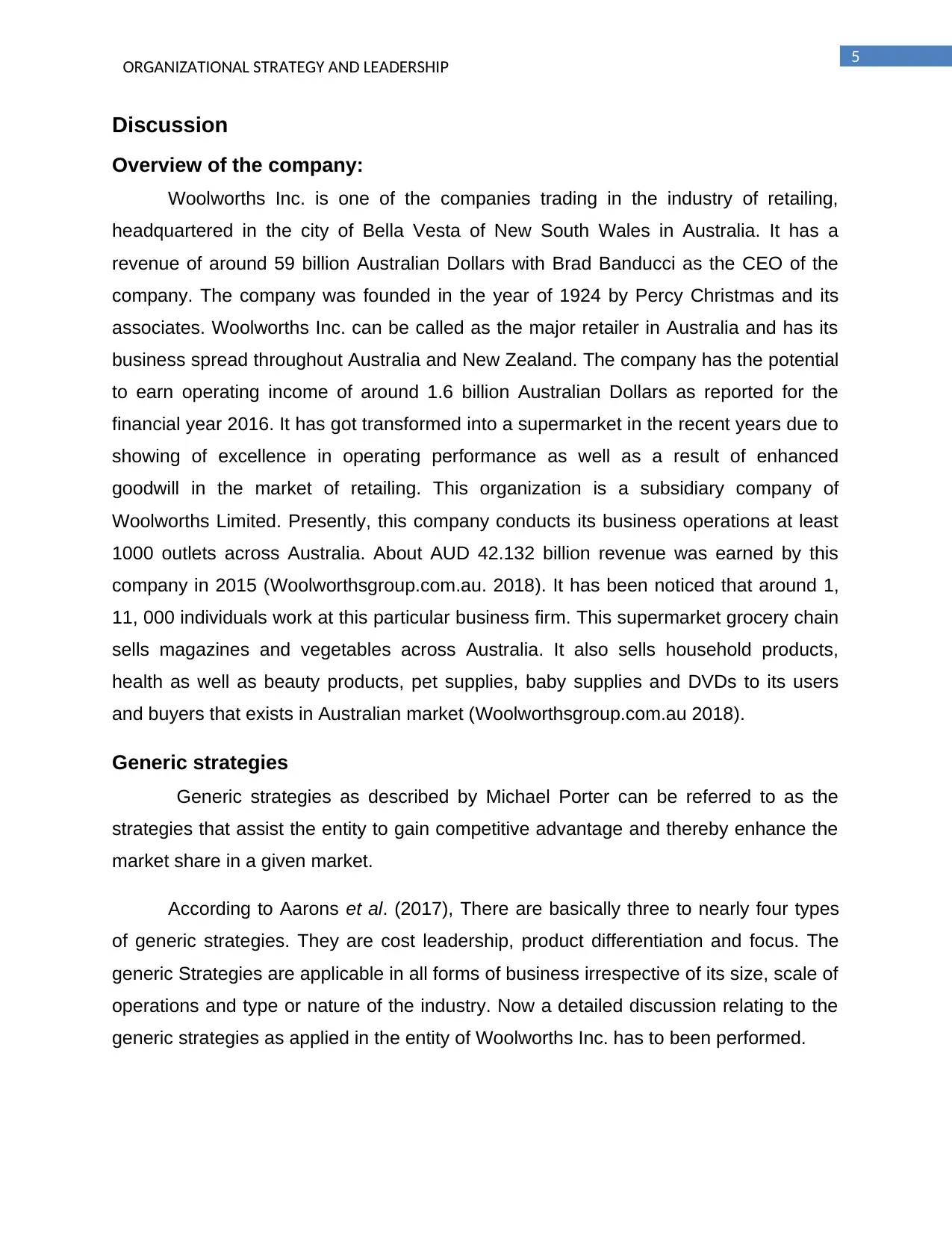
5
ORGANIZATIONAL STRATEGY AND LEADERSHIP
Discussion
Overview of the company:
Woolworths Inc. is one of the companies trading in the industry of retailing,
headquartered in the city of Bella Vesta of New South Wales in Australia. It has a
revenue of around 59 billion Australian Dollars with Brad Banducci as the CEO of the
company. The company was founded in the year of 1924 by Percy Christmas and its
associates. Woolworths Inc. can be called as the major retailer in Australia and has its
business spread throughout Australia and New Zealand. The company has the potential
to earn operating income of around 1.6 billion Australian Dollars as reported for the
financial year 2016. It has got transformed into a supermarket in the recent years due to
showing of excellence in operating performance as well as a result of enhanced
goodwill in the market of retailing. This organization is a subsidiary company of
Woolworths Limited. Presently, this company conducts its business operations at least
1000 outlets across Australia. About AUD 42.132 billion revenue was earned by this
company in 2015 (Woolworthsgroup.com.au. 2018). It has been noticed that around 1,
11, 000 individuals work at this particular business firm. This supermarket grocery chain
sells magazines and vegetables across Australia. It also sells household products,
health as well as beauty products, pet supplies, baby supplies and DVDs to its users
and buyers that exists in Australian market (Woolworthsgroup.com.au 2018).
Generic strategies
Generic strategies as described by Michael Porter can be referred to as the
strategies that assist the entity to gain competitive advantage and thereby enhance the
market share in a given market.
According to Aarons et al. (2017), There are basically three to nearly four types
of generic strategies. They are cost leadership, product differentiation and focus. The
generic Strategies are applicable in all forms of business irrespective of its size, scale of
operations and type or nature of the industry. Now a detailed discussion relating to the
generic strategies as applied in the entity of Woolworths Inc. has to been performed.
ORGANIZATIONAL STRATEGY AND LEADERSHIP
Discussion
Overview of the company:
Woolworths Inc. is one of the companies trading in the industry of retailing,
headquartered in the city of Bella Vesta of New South Wales in Australia. It has a
revenue of around 59 billion Australian Dollars with Brad Banducci as the CEO of the
company. The company was founded in the year of 1924 by Percy Christmas and its
associates. Woolworths Inc. can be called as the major retailer in Australia and has its
business spread throughout Australia and New Zealand. The company has the potential
to earn operating income of around 1.6 billion Australian Dollars as reported for the
financial year 2016. It has got transformed into a supermarket in the recent years due to
showing of excellence in operating performance as well as a result of enhanced
goodwill in the market of retailing. This organization is a subsidiary company of
Woolworths Limited. Presently, this company conducts its business operations at least
1000 outlets across Australia. About AUD 42.132 billion revenue was earned by this
company in 2015 (Woolworthsgroup.com.au. 2018). It has been noticed that around 1,
11, 000 individuals work at this particular business firm. This supermarket grocery chain
sells magazines and vegetables across Australia. It also sells household products,
health as well as beauty products, pet supplies, baby supplies and DVDs to its users
and buyers that exists in Australian market (Woolworthsgroup.com.au 2018).
Generic strategies
Generic strategies as described by Michael Porter can be referred to as the
strategies that assist the entity to gain competitive advantage and thereby enhance the
market share in a given market.
According to Aarons et al. (2017), There are basically three to nearly four types
of generic strategies. They are cost leadership, product differentiation and focus. The
generic Strategies are applicable in all forms of business irrespective of its size, scale of
operations and type or nature of the industry. Now a detailed discussion relating to the
generic strategies as applied in the entity of Woolworths Inc. has to been performed.
⊘ This is a preview!⊘
Do you want full access?
Subscribe today to unlock all pages.

Trusted by 1+ million students worldwide
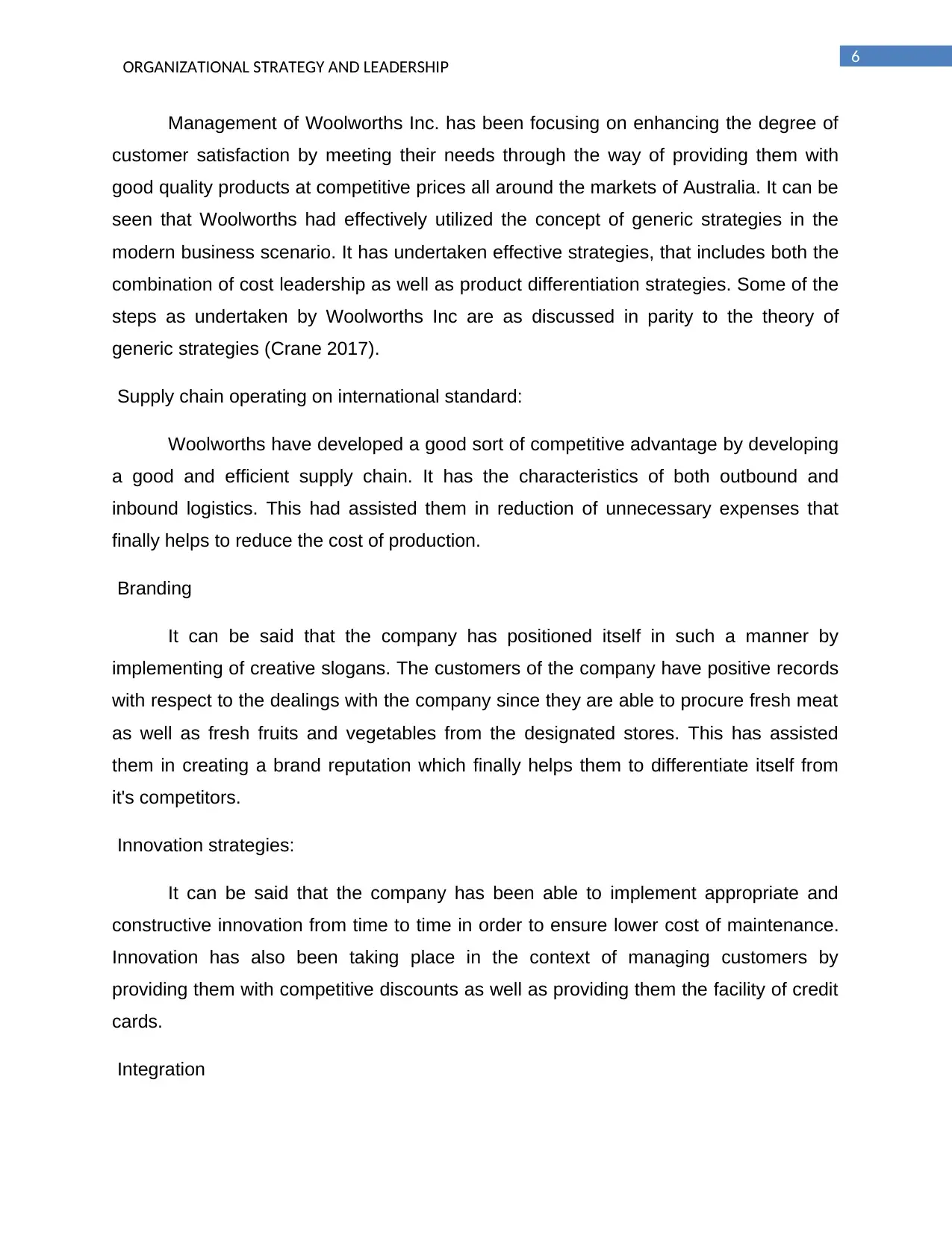
6
ORGANIZATIONAL STRATEGY AND LEADERSHIP
Management of Woolworths Inc. has been focusing on enhancing the degree of
customer satisfaction by meeting their needs through the way of providing them with
good quality products at competitive prices all around the markets of Australia. It can be
seen that Woolworths had effectively utilized the concept of generic strategies in the
modern business scenario. It has undertaken effective strategies, that includes both the
combination of cost leadership as well as product differentiation strategies. Some of the
steps as undertaken by Woolworths Inc are as discussed in parity to the theory of
generic strategies (Crane 2017).
Supply chain operating on international standard:
Woolworths have developed a good sort of competitive advantage by developing
a good and efficient supply chain. It has the characteristics of both outbound and
inbound logistics. This had assisted them in reduction of unnecessary expenses that
finally helps to reduce the cost of production.
Branding
It can be said that the company has positioned itself in such a manner by
implementing of creative slogans. The customers of the company have positive records
with respect to the dealings with the company since they are able to procure fresh meat
as well as fresh fruits and vegetables from the designated stores. This has assisted
them in creating a brand reputation which finally helps them to differentiate itself from
it's competitors.
Innovation strategies:
It can be said that the company has been able to implement appropriate and
constructive innovation from time to time in order to ensure lower cost of maintenance.
Innovation has also been taking place in the context of managing customers by
providing them with competitive discounts as well as providing them the facility of credit
cards.
Integration
ORGANIZATIONAL STRATEGY AND LEADERSHIP
Management of Woolworths Inc. has been focusing on enhancing the degree of
customer satisfaction by meeting their needs through the way of providing them with
good quality products at competitive prices all around the markets of Australia. It can be
seen that Woolworths had effectively utilized the concept of generic strategies in the
modern business scenario. It has undertaken effective strategies, that includes both the
combination of cost leadership as well as product differentiation strategies. Some of the
steps as undertaken by Woolworths Inc are as discussed in parity to the theory of
generic strategies (Crane 2017).
Supply chain operating on international standard:
Woolworths have developed a good sort of competitive advantage by developing
a good and efficient supply chain. It has the characteristics of both outbound and
inbound logistics. This had assisted them in reduction of unnecessary expenses that
finally helps to reduce the cost of production.
Branding
It can be said that the company has positioned itself in such a manner by
implementing of creative slogans. The customers of the company have positive records
with respect to the dealings with the company since they are able to procure fresh meat
as well as fresh fruits and vegetables from the designated stores. This has assisted
them in creating a brand reputation which finally helps them to differentiate itself from
it's competitors.
Innovation strategies:
It can be said that the company has been able to implement appropriate and
constructive innovation from time to time in order to ensure lower cost of maintenance.
Innovation has also been taking place in the context of managing customers by
providing them with competitive discounts as well as providing them the facility of credit
cards.
Integration
Paraphrase This Document
Need a fresh take? Get an instant paraphrase of this document with our AI Paraphraser
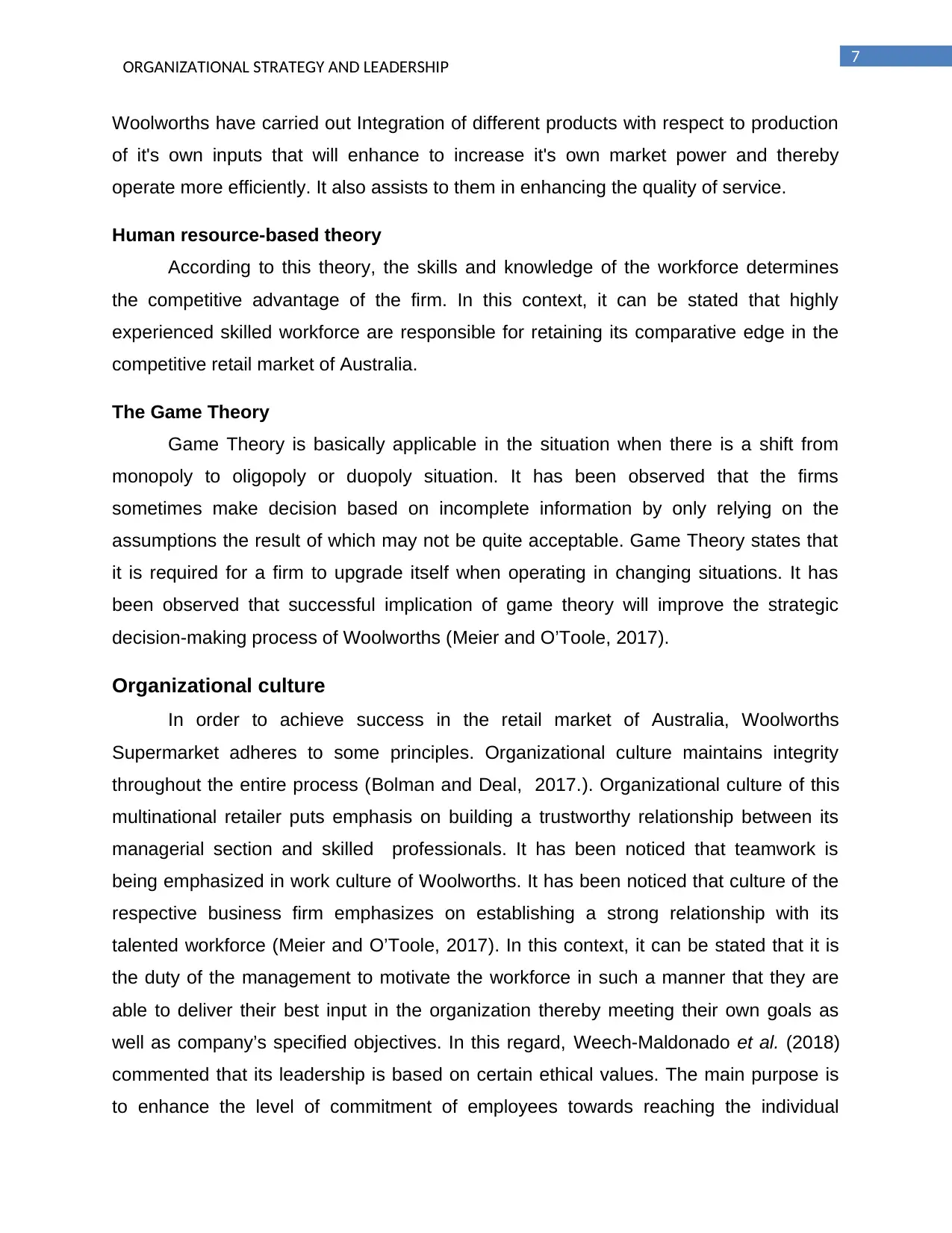
7
ORGANIZATIONAL STRATEGY AND LEADERSHIP
Woolworths have carried out Integration of different products with respect to production
of it's own inputs that will enhance to increase it's own market power and thereby
operate more efficiently. It also assists to them in enhancing the quality of service.
Human resource-based theory
According to this theory, the skills and knowledge of the workforce determines
the competitive advantage of the firm. In this context, it can be stated that highly
experienced skilled workforce are responsible for retaining its comparative edge in the
competitive retail market of Australia.
The Game Theory
Game Theory is basically applicable in the situation when there is a shift from
monopoly to oligopoly or duopoly situation. It has been observed that the firms
sometimes make decision based on incomplete information by only relying on the
assumptions the result of which may not be quite acceptable. Game Theory states that
it is required for a firm to upgrade itself when operating in changing situations. It has
been observed that successful implication of game theory will improve the strategic
decision-making process of Woolworths (Meier and O’Toole, 2017).
Organizational culture
In order to achieve success in the retail market of Australia, Woolworths
Supermarket adheres to some principles. Organizational culture maintains integrity
throughout the entire process (Bolman and Deal, 2017.). Organizational culture of this
multinational retailer puts emphasis on building a trustworthy relationship between its
managerial section and skilled professionals. It has been noticed that teamwork is
being emphasized in work culture of Woolworths. It has been noticed that culture of the
respective business firm emphasizes on establishing a strong relationship with its
talented workforce (Meier and O’Toole, 2017). In this context, it can be stated that it is
the duty of the management to motivate the workforce in such a manner that they are
able to deliver their best input in the organization thereby meeting their own goals as
well as company’s specified objectives. In this regard, Weech-Maldonado et al. (2018)
commented that its leadership is based on certain ethical values. The main purpose is
to enhance the level of commitment of employees towards reaching the individual
ORGANIZATIONAL STRATEGY AND LEADERSHIP
Woolworths have carried out Integration of different products with respect to production
of it's own inputs that will enhance to increase it's own market power and thereby
operate more efficiently. It also assists to them in enhancing the quality of service.
Human resource-based theory
According to this theory, the skills and knowledge of the workforce determines
the competitive advantage of the firm. In this context, it can be stated that highly
experienced skilled workforce are responsible for retaining its comparative edge in the
competitive retail market of Australia.
The Game Theory
Game Theory is basically applicable in the situation when there is a shift from
monopoly to oligopoly or duopoly situation. It has been observed that the firms
sometimes make decision based on incomplete information by only relying on the
assumptions the result of which may not be quite acceptable. Game Theory states that
it is required for a firm to upgrade itself when operating in changing situations. It has
been observed that successful implication of game theory will improve the strategic
decision-making process of Woolworths (Meier and O’Toole, 2017).
Organizational culture
In order to achieve success in the retail market of Australia, Woolworths
Supermarket adheres to some principles. Organizational culture maintains integrity
throughout the entire process (Bolman and Deal, 2017.). Organizational culture of this
multinational retailer puts emphasis on building a trustworthy relationship between its
managerial section and skilled professionals. It has been noticed that teamwork is
being emphasized in work culture of Woolworths. It has been noticed that culture of the
respective business firm emphasizes on establishing a strong relationship with its
talented workforce (Meier and O’Toole, 2017). In this context, it can be stated that it is
the duty of the management to motivate the workforce in such a manner that they are
able to deliver their best input in the organization thereby meeting their own goals as
well as company’s specified objectives. In this regard, Weech-Maldonado et al. (2018)
commented that its leadership is based on certain ethical values. The main purpose is
to enhance the level of commitment of employees towards reaching the individual
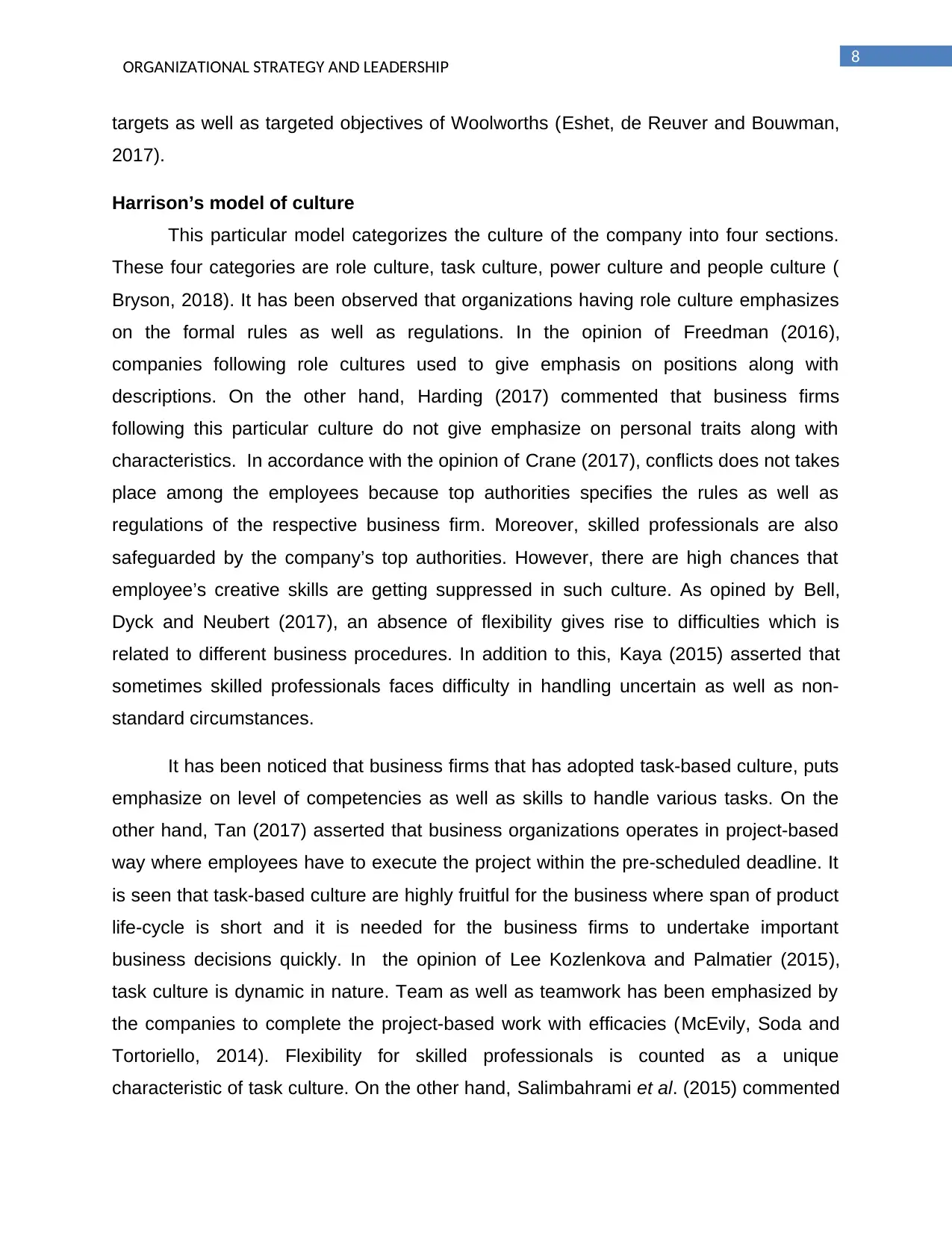
8
ORGANIZATIONAL STRATEGY AND LEADERSHIP
targets as well as targeted objectives of Woolworths (Eshet, de Reuver and Bouwman,
2017).
Harrison’s model of culture
This particular model categorizes the culture of the company into four sections.
These four categories are role culture, task culture, power culture and people culture (
Bryson, 2018). It has been observed that organizations having role culture emphasizes
on the formal rules as well as regulations. In the opinion of Freedman (2016),
companies following role cultures used to give emphasis on positions along with
descriptions. On the other hand, Harding (2017) commented that business firms
following this particular culture do not give emphasize on personal traits along with
characteristics. In accordance with the opinion of Crane (2017), conflicts does not takes
place among the employees because top authorities specifies the rules as well as
regulations of the respective business firm. Moreover, skilled professionals are also
safeguarded by the company’s top authorities. However, there are high chances that
employee’s creative skills are getting suppressed in such culture. As opined by Bell,
Dyck and Neubert (2017), an absence of flexibility gives rise to difficulties which is
related to different business procedures. In addition to this, Kaya (2015) asserted that
sometimes skilled professionals faces difficulty in handling uncertain as well as non-
standard circumstances.
It has been noticed that business firms that has adopted task-based culture, puts
emphasize on level of competencies as well as skills to handle various tasks. On the
other hand, Tan (2017) asserted that business organizations operates in project-based
way where employees have to execute the project within the pre-scheduled deadline. It
is seen that task-based culture are highly fruitful for the business where span of product
life-cycle is short and it is needed for the business firms to undertake important
business decisions quickly. In the opinion of Lee Kozlenkova and Palmatier (2015),
task culture is dynamic in nature. Team as well as teamwork has been emphasized by
the companies to complete the project-based work with efficacies (McEvily, Soda and
Tortoriello, 2014). Flexibility for skilled professionals is counted as a unique
characteristic of task culture. On the other hand, Salimbahrami et al. (2015) commented
ORGANIZATIONAL STRATEGY AND LEADERSHIP
targets as well as targeted objectives of Woolworths (Eshet, de Reuver and Bouwman,
2017).
Harrison’s model of culture
This particular model categorizes the culture of the company into four sections.
These four categories are role culture, task culture, power culture and people culture (
Bryson, 2018). It has been observed that organizations having role culture emphasizes
on the formal rules as well as regulations. In the opinion of Freedman (2016),
companies following role cultures used to give emphasis on positions along with
descriptions. On the other hand, Harding (2017) commented that business firms
following this particular culture do not give emphasize on personal traits along with
characteristics. In accordance with the opinion of Crane (2017), conflicts does not takes
place among the employees because top authorities specifies the rules as well as
regulations of the respective business firm. Moreover, skilled professionals are also
safeguarded by the company’s top authorities. However, there are high chances that
employee’s creative skills are getting suppressed in such culture. As opined by Bell,
Dyck and Neubert (2017), an absence of flexibility gives rise to difficulties which is
related to different business procedures. In addition to this, Kaya (2015) asserted that
sometimes skilled professionals faces difficulty in handling uncertain as well as non-
standard circumstances.
It has been noticed that business firms that has adopted task-based culture, puts
emphasize on level of competencies as well as skills to handle various tasks. On the
other hand, Tan (2017) asserted that business organizations operates in project-based
way where employees have to execute the project within the pre-scheduled deadline. It
is seen that task-based culture are highly fruitful for the business where span of product
life-cycle is short and it is needed for the business firms to undertake important
business decisions quickly. In the opinion of Lee Kozlenkova and Palmatier (2015),
task culture is dynamic in nature. Team as well as teamwork has been emphasized by
the companies to complete the project-based work with efficacies (McEvily, Soda and
Tortoriello, 2014). Flexibility for skilled professionals is counted as a unique
characteristic of task culture. On the other hand, Salimbahrami et al. (2015) commented
⊘ This is a preview!⊘
Do you want full access?
Subscribe today to unlock all pages.

Trusted by 1+ million students worldwide
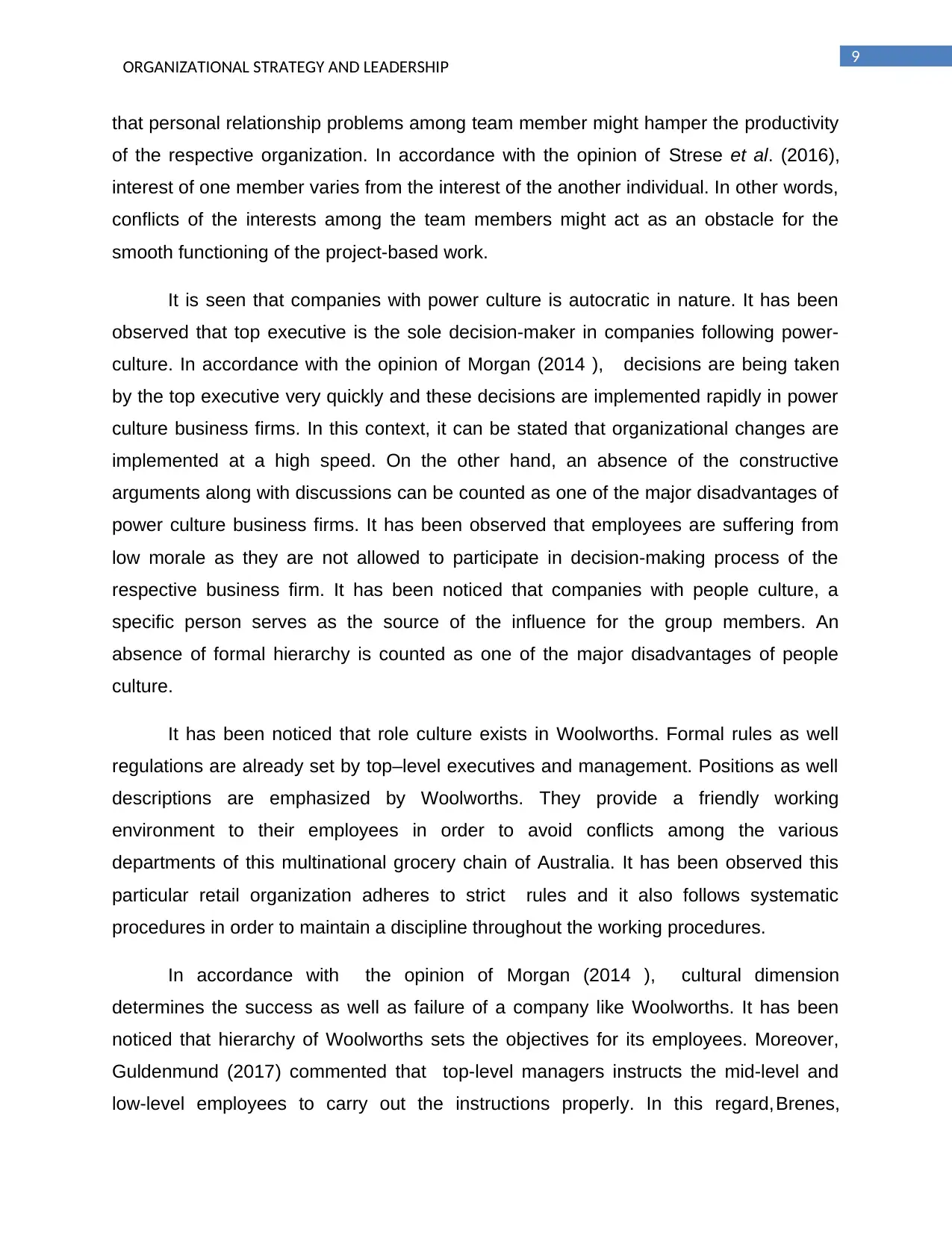
9
ORGANIZATIONAL STRATEGY AND LEADERSHIP
that personal relationship problems among team member might hamper the productivity
of the respective organization. In accordance with the opinion of Strese et al. (2016),
interest of one member varies from the interest of the another individual. In other words,
conflicts of the interests among the team members might act as an obstacle for the
smooth functioning of the project-based work.
It is seen that companies with power culture is autocratic in nature. It has been
observed that top executive is the sole decision-maker in companies following power-
culture. In accordance with the opinion of Morgan (2014 ), decisions are being taken
by the top executive very quickly and these decisions are implemented rapidly in power
culture business firms. In this context, it can be stated that organizational changes are
implemented at a high speed. On the other hand, an absence of the constructive
arguments along with discussions can be counted as one of the major disadvantages of
power culture business firms. It has been observed that employees are suffering from
low morale as they are not allowed to participate in decision-making process of the
respective business firm. It has been noticed that companies with people culture, a
specific person serves as the source of the influence for the group members. An
absence of formal hierarchy is counted as one of the major disadvantages of people
culture.
It has been noticed that role culture exists in Woolworths. Formal rules as well
regulations are already set by top–level executives and management. Positions as well
descriptions are emphasized by Woolworths. They provide a friendly working
environment to their employees in order to avoid conflicts among the various
departments of this multinational grocery chain of Australia. It has been observed this
particular retail organization adheres to strict rules and it also follows systematic
procedures in order to maintain a discipline throughout the working procedures.
In accordance with the opinion of Morgan (2014 ), cultural dimension
determines the success as well as failure of a company like Woolworths. It has been
noticed that hierarchy of Woolworths sets the objectives for its employees. Moreover,
Guldenmund (2017) commented that top-level managers instructs the mid-level and
low-level employees to carry out the instructions properly. In this regard,Brenes,
ORGANIZATIONAL STRATEGY AND LEADERSHIP
that personal relationship problems among team member might hamper the productivity
of the respective organization. In accordance with the opinion of Strese et al. (2016),
interest of one member varies from the interest of the another individual. In other words,
conflicts of the interests among the team members might act as an obstacle for the
smooth functioning of the project-based work.
It is seen that companies with power culture is autocratic in nature. It has been
observed that top executive is the sole decision-maker in companies following power-
culture. In accordance with the opinion of Morgan (2014 ), decisions are being taken
by the top executive very quickly and these decisions are implemented rapidly in power
culture business firms. In this context, it can be stated that organizational changes are
implemented at a high speed. On the other hand, an absence of the constructive
arguments along with discussions can be counted as one of the major disadvantages of
power culture business firms. It has been observed that employees are suffering from
low morale as they are not allowed to participate in decision-making process of the
respective business firm. It has been noticed that companies with people culture, a
specific person serves as the source of the influence for the group members. An
absence of formal hierarchy is counted as one of the major disadvantages of people
culture.
It has been noticed that role culture exists in Woolworths. Formal rules as well
regulations are already set by top–level executives and management. Positions as well
descriptions are emphasized by Woolworths. They provide a friendly working
environment to their employees in order to avoid conflicts among the various
departments of this multinational grocery chain of Australia. It has been observed this
particular retail organization adheres to strict rules and it also follows systematic
procedures in order to maintain a discipline throughout the working procedures.
In accordance with the opinion of Morgan (2014 ), cultural dimension
determines the success as well as failure of a company like Woolworths. It has been
noticed that hierarchy of Woolworths sets the objectives for its employees. Moreover,
Guldenmund (2017) commented that top-level managers instructs the mid-level and
low-level employees to carry out the instructions properly. In this regard,Brenes,
Paraphrase This Document
Need a fresh take? Get an instant paraphrase of this document with our AI Paraphraser
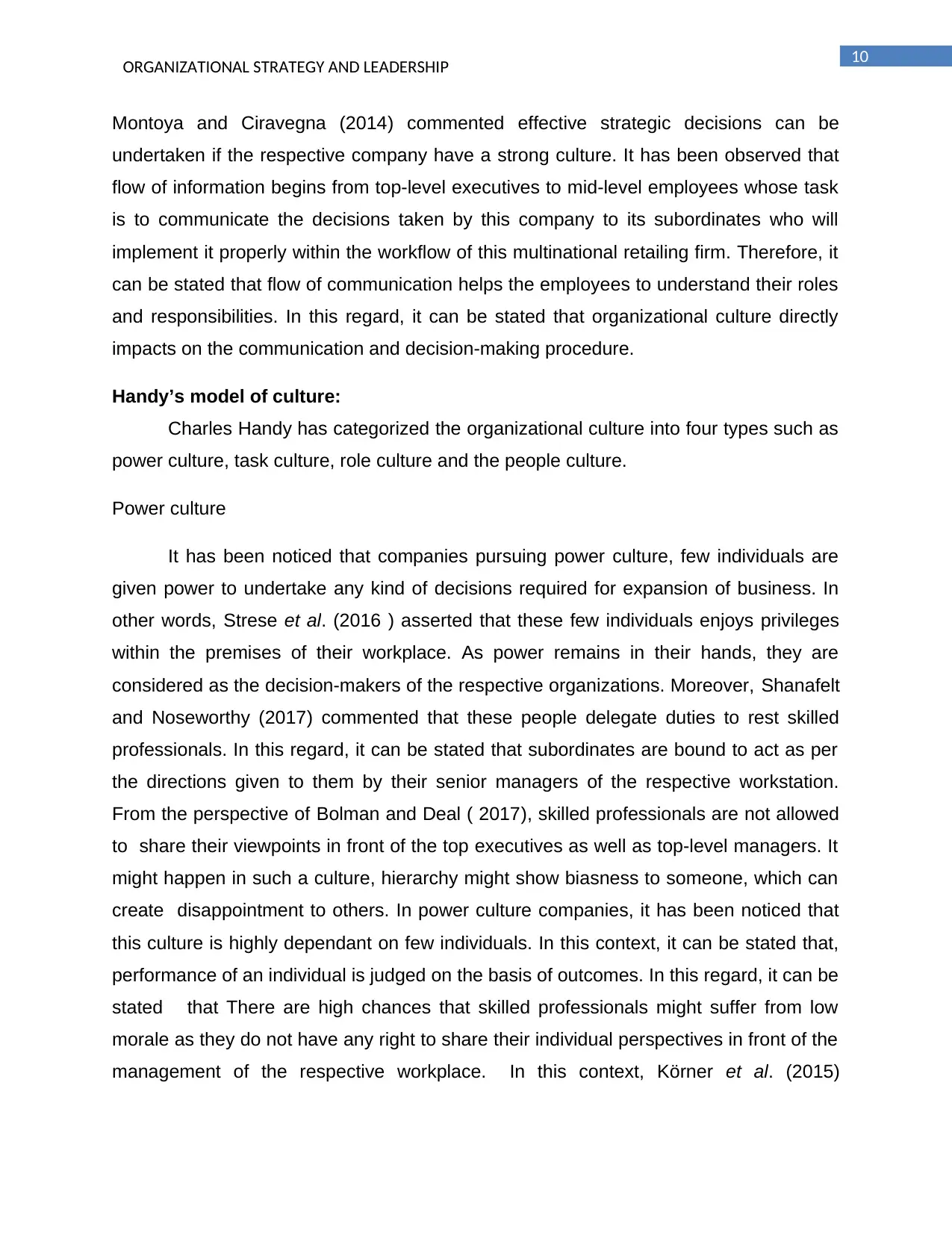
10
ORGANIZATIONAL STRATEGY AND LEADERSHIP
Montoya and Ciravegna (2014) commented effective strategic decisions can be
undertaken if the respective company have a strong culture. It has been observed that
flow of information begins from top-level executives to mid-level employees whose task
is to communicate the decisions taken by this company to its subordinates who will
implement it properly within the workflow of this multinational retailing firm. Therefore, it
can be stated that flow of communication helps the employees to understand their roles
and responsibilities. In this regard, it can be stated that organizational culture directly
impacts on the communication and decision-making procedure.
Handy’s model of culture:
Charles Handy has categorized the organizational culture into four types such as
power culture, task culture, role culture and the people culture.
Power culture
It has been noticed that companies pursuing power culture, few individuals are
given power to undertake any kind of decisions required for expansion of business. In
other words, Strese et al. (2016 ) asserted that these few individuals enjoys privileges
within the premises of their workplace. As power remains in their hands, they are
considered as the decision-makers of the respective organizations. Moreover, Shanafelt
and Noseworthy (2017) commented that these people delegate duties to rest skilled
professionals. In this regard, it can be stated that subordinates are bound to act as per
the directions given to them by their senior managers of the respective workstation.
From the perspective of Bolman and Deal ( 2017), skilled professionals are not allowed
to share their viewpoints in front of the top executives as well as top-level managers. It
might happen in such a culture, hierarchy might show biasness to someone, which can
create disappointment to others. In power culture companies, it has been noticed that
this culture is highly dependant on few individuals. In this context, it can be stated that,
performance of an individual is judged on the basis of outcomes. In this regard, it can be
stated that There are high chances that skilled professionals might suffer from low
morale as they do not have any right to share their individual perspectives in front of the
management of the respective workplace. In this context, Körner et al. (2015)
ORGANIZATIONAL STRATEGY AND LEADERSHIP
Montoya and Ciravegna (2014) commented effective strategic decisions can be
undertaken if the respective company have a strong culture. It has been observed that
flow of information begins from top-level executives to mid-level employees whose task
is to communicate the decisions taken by this company to its subordinates who will
implement it properly within the workflow of this multinational retailing firm. Therefore, it
can be stated that flow of communication helps the employees to understand their roles
and responsibilities. In this regard, it can be stated that organizational culture directly
impacts on the communication and decision-making procedure.
Handy’s model of culture:
Charles Handy has categorized the organizational culture into four types such as
power culture, task culture, role culture and the people culture.
Power culture
It has been noticed that companies pursuing power culture, few individuals are
given power to undertake any kind of decisions required for expansion of business. In
other words, Strese et al. (2016 ) asserted that these few individuals enjoys privileges
within the premises of their workplace. As power remains in their hands, they are
considered as the decision-makers of the respective organizations. Moreover, Shanafelt
and Noseworthy (2017) commented that these people delegate duties to rest skilled
professionals. In this regard, it can be stated that subordinates are bound to act as per
the directions given to them by their senior managers of the respective workstation.
From the perspective of Bolman and Deal ( 2017), skilled professionals are not allowed
to share their viewpoints in front of the top executives as well as top-level managers. It
might happen in such a culture, hierarchy might show biasness to someone, which can
create disappointment to others. In power culture companies, it has been noticed that
this culture is highly dependant on few individuals. In this context, it can be stated that,
performance of an individual is judged on the basis of outcomes. In this regard, it can be
stated that There are high chances that skilled professionals might suffer from low
morale as they do not have any right to share their individual perspectives in front of the
management of the respective workplace. In this context, Körner et al. (2015)
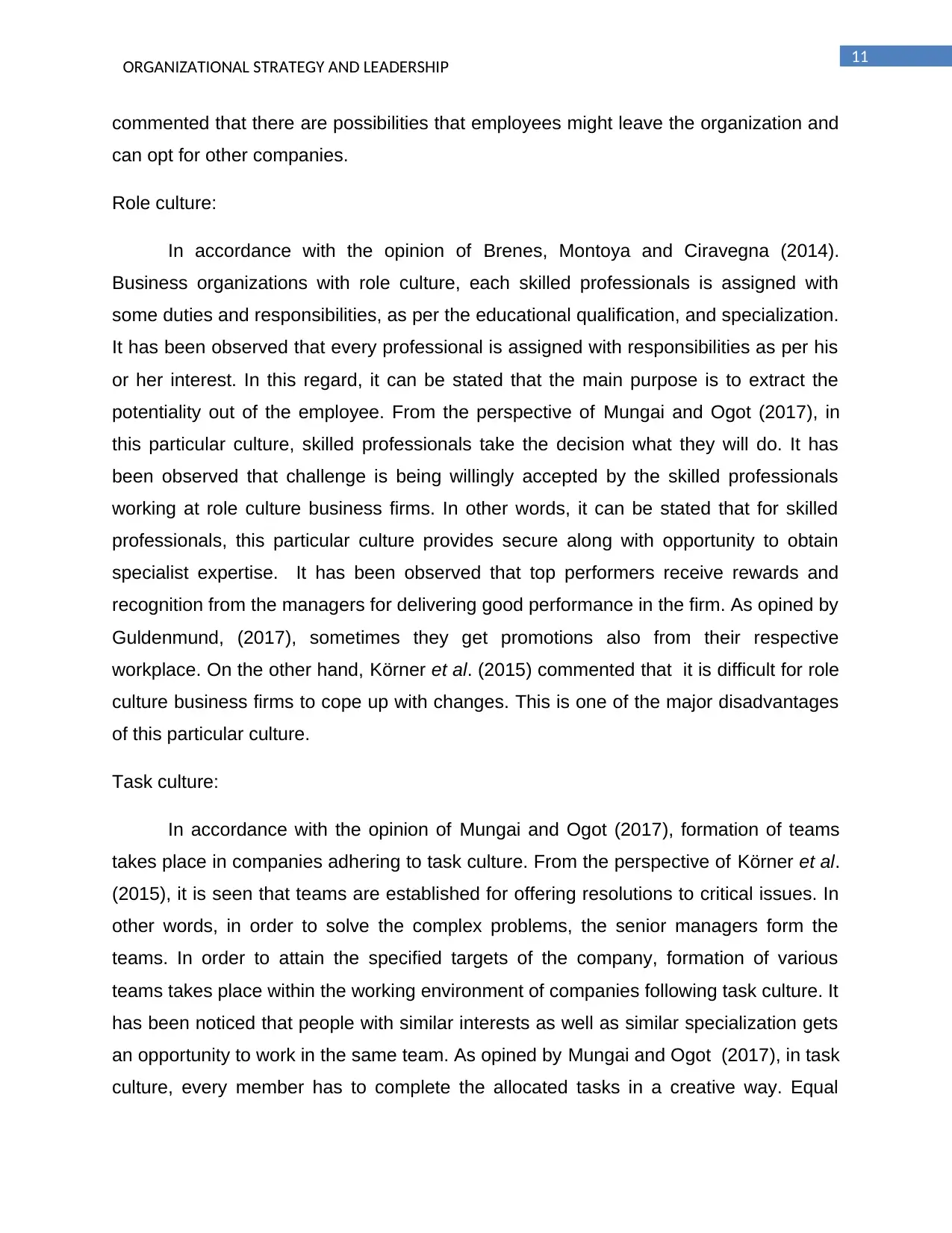
11
ORGANIZATIONAL STRATEGY AND LEADERSHIP
commented that there are possibilities that employees might leave the organization and
can opt for other companies.
Role culture:
In accordance with the opinion of Brenes, Montoya and Ciravegna (2014).
Business organizations with role culture, each skilled professionals is assigned with
some duties and responsibilities, as per the educational qualification, and specialization.
It has been observed that every professional is assigned with responsibilities as per his
or her interest. In this regard, it can be stated that the main purpose is to extract the
potentiality out of the employee. From the perspective of Mungai and Ogot (2017), in
this particular culture, skilled professionals take the decision what they will do. It has
been observed that challenge is being willingly accepted by the skilled professionals
working at role culture business firms. In other words, it can be stated that for skilled
professionals, this particular culture provides secure along with opportunity to obtain
specialist expertise. It has been observed that top performers receive rewards and
recognition from the managers for delivering good performance in the firm. As opined by
Guldenmund, (2017), sometimes they get promotions also from their respective
workplace. On the other hand, Körner et al. (2015) commented that it is difficult for role
culture business firms to cope up with changes. This is one of the major disadvantages
of this particular culture.
Task culture:
In accordance with the opinion of Mungai and Ogot (2017), formation of teams
takes place in companies adhering to task culture. From the perspective of Körner et al.
(2015), it is seen that teams are established for offering resolutions to critical issues. In
other words, in order to solve the complex problems, the senior managers form the
teams. In order to attain the specified targets of the company, formation of various
teams takes place within the working environment of companies following task culture. It
has been noticed that people with similar interests as well as similar specialization gets
an opportunity to work in the same team. As opined by Mungai and Ogot (2017), in task
culture, every member has to complete the allocated tasks in a creative way. Equal
ORGANIZATIONAL STRATEGY AND LEADERSHIP
commented that there are possibilities that employees might leave the organization and
can opt for other companies.
Role culture:
In accordance with the opinion of Brenes, Montoya and Ciravegna (2014).
Business organizations with role culture, each skilled professionals is assigned with
some duties and responsibilities, as per the educational qualification, and specialization.
It has been observed that every professional is assigned with responsibilities as per his
or her interest. In this regard, it can be stated that the main purpose is to extract the
potentiality out of the employee. From the perspective of Mungai and Ogot (2017), in
this particular culture, skilled professionals take the decision what they will do. It has
been observed that challenge is being willingly accepted by the skilled professionals
working at role culture business firms. In other words, it can be stated that for skilled
professionals, this particular culture provides secure along with opportunity to obtain
specialist expertise. It has been observed that top performers receive rewards and
recognition from the managers for delivering good performance in the firm. As opined by
Guldenmund, (2017), sometimes they get promotions also from their respective
workplace. On the other hand, Körner et al. (2015) commented that it is difficult for role
culture business firms to cope up with changes. This is one of the major disadvantages
of this particular culture.
Task culture:
In accordance with the opinion of Mungai and Ogot (2017), formation of teams
takes place in companies adhering to task culture. From the perspective of Körner et al.
(2015), it is seen that teams are established for offering resolutions to critical issues. In
other words, in order to solve the complex problems, the senior managers form the
teams. In order to attain the specified targets of the company, formation of various
teams takes place within the working environment of companies following task culture. It
has been noticed that people with similar interests as well as similar specialization gets
an opportunity to work in the same team. As opined by Mungai and Ogot (2017), in task
culture, every member has to complete the allocated tasks in a creative way. Equal
⊘ This is a preview!⊘
Do you want full access?
Subscribe today to unlock all pages.

Trusted by 1+ million students worldwide
1 out of 19
Related Documents
Your All-in-One AI-Powered Toolkit for Academic Success.
+13062052269
info@desklib.com
Available 24*7 on WhatsApp / Email
![[object Object]](/_next/static/media/star-bottom.7253800d.svg)
Unlock your academic potential
Copyright © 2020–2025 A2Z Services. All Rights Reserved. Developed and managed by ZUCOL.





